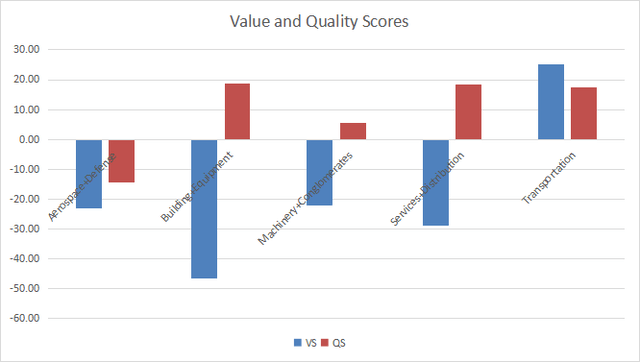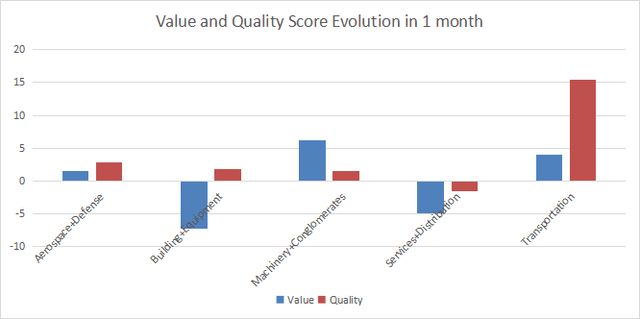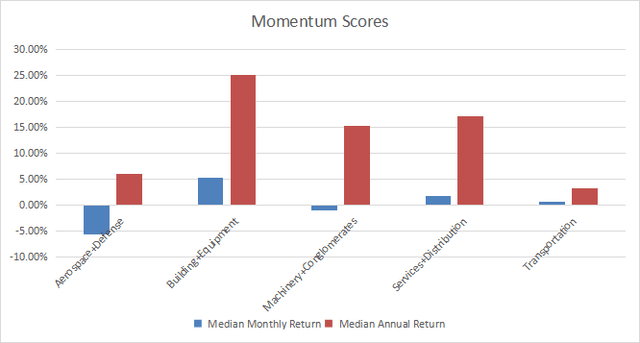RGI: Industrials Dashboard For May
Summary
- Transportation has the best value and quality scores in the sector.
- Other subsectors are overvalued by 22% to 46% relative to 11-year averages.
- RGI, an equal-weight alternative to XLI.
- 10 stocks cheaper than their peers in May.
- Quantitative Risk & Value members get exclusive access to our real-world portfolio. See all our investments here »
Tryaging
This monthly article series shows a dashboard with aggregate subsector metrics in industrials. It is also a review of sector ETFs like Industrial Select Sector SPDR ETF (XLI), Fidelity MSCI Industrials Index ETF (FIDU) and Invesco S&P 500 Equal Weight Industrials ETF (NYSEARCA:RGI), whose largest holdings are used to calculate these metrics.
Shortcut
The next two paragraphs in italics describe the dashboard methodology. They are necessary for new readers to understand the metrics. If you are used to this series or if you are short of time, you can skip them and go to the charts.
Base Metrics
I calculate the median value of five fundamental ratios for each subsector: Earnings Yield ("EY"), Sales Yield ("SY"), Free Cash Flow Yield ("FY"), Return on Equity ("ROE"), Gross Margin ("GM"). The reference universe includes large companies in the U.S. stock market. The five base metrics are calculated on trailing 12 months. For all of them, higher is better. EY, SY and FY are medians of the inverse of Price/Earnings, Price/Sales and Price/Free Cash Flow. They are better for statistical studies than price-to-something ratios, which are unusable or non-available when the "something" is close to zero or negative (for example, companies with negative earnings). I also look at two momentum metrics for each group: the median monthly return (RetM) and the median annual return (RetY).
I prefer medians to averages because a median splits a set in a good half and a bad half. A capital-weighted average is skewed by extreme values and the largest companies. My metrics are designed for stock-picking rather than index investing.
Value and Quality Scores
I calculate historical baselines for all metrics. They are noted respectively EYh, SYh, FYh, ROEh, GMh, and they are calculated as the averages on a look-back period of 11 years. For example, the value of EYh for transportation in the table below is the 11-year average of the median Earnings Yield in transportation companies. The Value Score ("VS") is defined as the average difference in % between the three valuation ratios (EY, SY, FY) and their baselines (EYh, SYh, FYh). The same way, the Quality Score ("QS") is the average difference between the two quality ratios (ROE, GM) and their baselines (ROEh, GMh).
The scores are in percentage points. VS may be interpreted as the percentage of undervaluation or overvaluation relative to the baseline (positive is good, negative is bad). This interpretation must be taken with caution: the baseline is an arbitrary reference, not a supposed fair value. The formula assumes that the three valuation metrics are of equal importance.
Current Data
The next table shows the metrics and scores as of last week's closing. Columns stand for all the data named and defined above.
VS | QS | EY | SY | FY | ROE | GM | EYh | SYh | FYh | ROEh | GMh | RetM | RetY | |
Aerospace+Defense | -23.05 | -14.55 | 0.0435 | 0.5578 | 0.0272 | 14.84 | 21.50 | 0.0522 | 0.7479 | 0.0373 | 20.27 | 22.02 | -5.66% | 5.99% |
Building+Equipment | -46.53 | 18.69 | 0.0287 | 0.2941 | 0.0127 | 11.63 | 31.59 | 0.0422 | 0.7962 | 0.0229 | 9.77 | 26.70 | 5.31% | 25.09% |
Machinery+Conglomerates | -22.15 | 5.66 | 0.0404 | 0.3716 | 0.0237 | 21.22 | 38.50 | 0.0482 | 0.5293 | 0.0298 | 19.38 | 37.82 | -0.89% | 15.40% |
Services+Distribution | -29.06 | 18.36 | 0.0331 | 0.2947 | 0.0178 | 34.69 | 46.01 | 0.0394 | 0.4471 | 0.0283 | 24.21 | 49.26 | 1.88% | 17.25% |
Transportation | 25.21 | 17.33 | 0.0607 | 1.1299 | 0.0223 | 35.40 | 23.28 | 0.0541 | 0.7257 | 0.0207 | 24.08 | 26.56 | 0.70% | 3.29% |
Value and Quality Chart
The next chart plots the Value and Quality Scores by subsector (higher is better).
Value and quality in industrials (Chart: author; data: Portfolio123)
Evolution Since Last Month
Value and quality scores have improved in transportation, which was already the most attractive subsector.
Variations in value and quality (Chart: author; data: Portfolio123)
Momentum
The next chart plots momentum based on median returns by subsector.
Momentum in industrials (Chart: author; data: Portfolio123)
Interpretation
Transportation is the most attractive industry regarding both value and quality scores. It is undervalued by about 25% relative to 11-year averages, and quality is above the historical baseline. Other subsectors are overvalued by 22% to 46%. Overvaluation may be partly offset by good quality scores for building/construction/electric equipment and services/distribution, albeit the former is the most overvalued subsector. Aerospace/defense is below the baseline in both value and quality.
Focus on RGI
Invesco S&P 500 Equal Weight Industrials ETF (RGI) has been tracking the S&P 500 Equal Weight Industrials Index since 11/01/2006. It has a total expense ratio of 0.40%, whereas XLI and FIDU charge only 0.10% and 0.08%, respectively.
The fund holds 78 stocks as of writing. All positions have the same weight after every rebalancing, but they may drift with price action. The next table shows the top 10 holdings now with fundamental ratios. These are the constituents with the highest momentum since the last rebalancing. Their aggregate weight is 15.2% of asset value.
Ticker | Name | Weight% | EPS growth %TTM | P/E TTM | P/E fwd | Yield% |
Copart, Inc. | 1.68 | 6.25 | 36.26 | 35.02 | 0 | |
Verisk Analytics, Inc. | 1.59 | -48.25 | 67.44 | 39.07 | 0.63 | |
CoStar Group, Inc. | 1.56 | 17.04 | 85.81 | 63.48 | 0 | |
Rollins, Inc. | 1.53 | 15.02 | 51.57 | 45.17 | 1.31 | |
FedEx Corp. | 1.50 | -39.21 | 19.57 | 15.30 | 2.22 | |
Republic Services, Inc. | 1.49 | 13.45 | 29.78 | 27.08 | 1.39 | |
General Electric Co. | 1.49 | N/A | 13.65 | 49.66 | 0.31 | |
Broadridge Financial Solutions, Inc. | 1.47 | 0.18 | 32.37 | 21.84 | 1.92 | |
Pentair plc | 1.46 | -8.05 | 19.37 | 15.84 | 1.52 | |
TransDigm Group, Inc. | 1.45 | 16.52 | 46.80 | 32.57 | 0 |
The heaviest industry in the portfolio is machinery (22.4% of assets), whereas it is aerospace and defense in the capital-weighted fund XLI (20% of assets).
RGI has outperformed XLI by 0.9% in annualized return since November 2006. Risk metrics are similar (drawdown and volatility).
Total Return | Annual. Return | Drawdown | Sharpe | Volatility | |
RGI | 362.22% | 9.69% | -60.87% | 0.52 | 19.87% |
XLI | 303.03% | 8.78% | -62.26% | 0.48 | 19.63% |
RGI is a good instrument for investors seeking an ETF in industrials with a lower exposure to large companies, and also to aerospace and defense.
Dashboard List
I use the first table to calculate value and quality scores. It may also be used in a stock-picking process to check how companies stand among their peers. For example, the EY column tells us that a transportation company with an Earnings Yield above 0.0607 (or price/earnings below 16.47) is in the better half of the subsector regarding this metric. A Dashboard List is sent every month to Quantitative Risk & Value subscribers with the most profitable companies standing in the better half among their peers regarding the three valuation metrics at the same time. The list below was sent to subscribers several weeks ago based on data available at this time.
The Brink's Co. | |
Insperity, Inc. | |
Boise Cascade Co. | |
Encore Wire Corp. (Delaware) | |
Builders FirstSource, Inc. | |
Matson, Inc. | |
Titan International, Inc. | |
C.H. Robinson Worldwide, Inc. | |
Vontier Corp. | |
XPO, Inc. |
It is a rotational model with a statistical bias toward excess returns on the long term, not the result of an analysis of each stock.
Quantitative Risk & Value (QRV) features data-driven strategies in stocks and closed-end funds outperforming their benchmarks since inception. Get started with a two-week free trial now.
This article was written by
Step up your investing experience: try Quantitative Risk & Value for free now (limited offer).
I am an individual investor and an IT professional, not a finance professional. My writings are data analysis and opinions, not investment advice. They may contain inaccurate information, despite all the effort I put in them. Readers are responsible for all consequences of using information included in my work, and are encouraged to do their own research from various sources.
Analyst’s Disclosure: I/we have no stock, option or similar derivative position in any of the companies mentioned, and no plans to initiate any such positions within the next 72 hours. I wrote this article myself, and it expresses my own opinions. I am not receiving compensation for it (other than from Seeking Alpha). I have no business relationship with any company whose stock is mentioned in this article.
Seeking Alpha's Disclosure: Past performance is no guarantee of future results. No recommendation or advice is being given as to whether any investment is suitable for a particular investor. Any views or opinions expressed above may not reflect those of Seeking Alpha as a whole. Seeking Alpha is not a licensed securities dealer, broker or US investment adviser or investment bank. Our analysts are third party authors that include both professional investors and individual investors who may not be licensed or certified by any institute or regulatory body.


